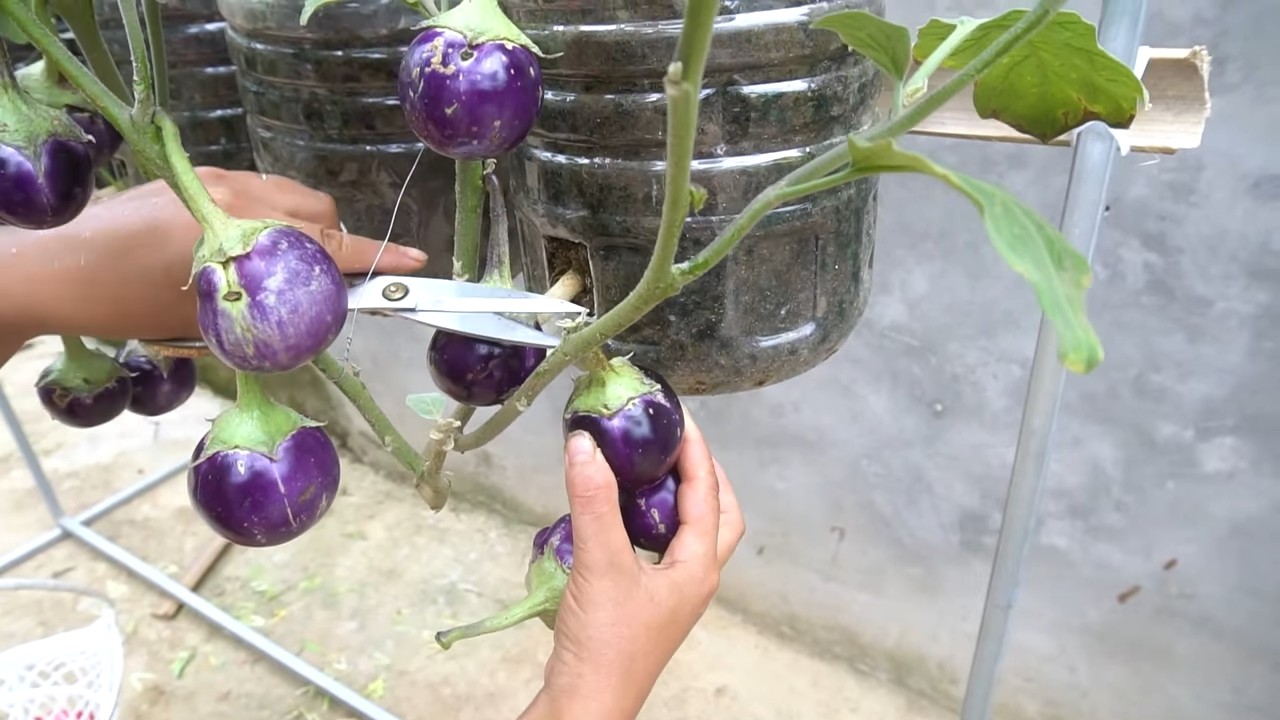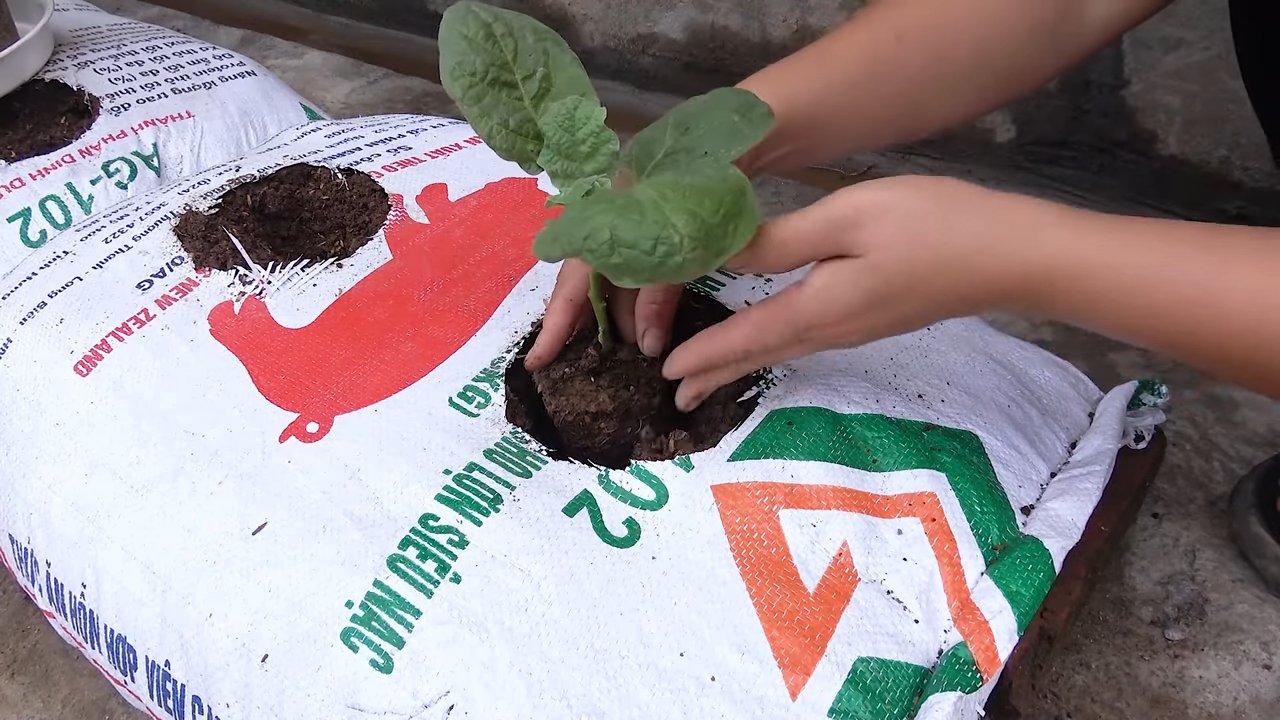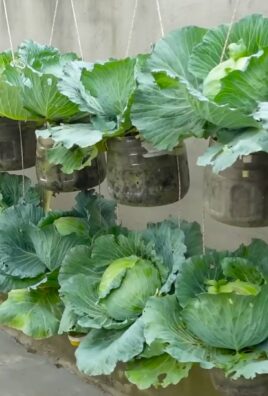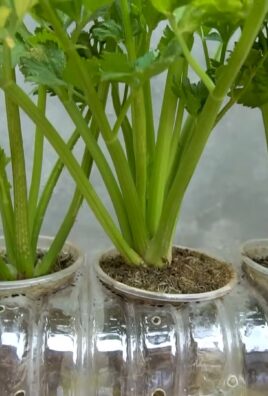Growing eggplants at home can seem daunting, but trust me, with a few clever tricks and a little DIY spirit, you can be harvesting your own glossy, purple beauties in no time! Forget those bland, overpriced eggplants at the grocery store. Imagine sinking your teeth into a freshly picked eggplant, bursting with flavor, knowing you nurtured it from seed to table.
Eggplants have a rich history, dating back thousands of years to ancient Asia, where they were prized for both their culinary and medicinal properties. Over centuries, different varieties have emerged, each with its unique shape, size, and color. From the slender Japanese types to the round Italian heirlooms, the eggplant has truly become a global culinary staple.
But why bother with the effort of growing your own? Well, for starters, homegrown eggplants taste infinitely better! Plus, you have complete control over what goes into your food, avoiding harmful pesticides and ensuring the freshest possible produce. In this article, I’m going to share some of my favorite DIY hacks and tips for growing eggplants at home, even if you have limited space or a less-than-green thumb. We’ll cover everything from seed starting to pest control, ensuring you have a bountiful harvest. Get ready to roll up your sleeves and transform your garden into an eggplant paradise!

Growing Eggplants at Home: A Beginner’s Guide
Hey there, fellow gardening enthusiasts! I’m so excited to share my experiences with growing eggplants at home. It might seem a little intimidating at first, but trust me, with a little patience and the right guidance, you can harvest your own delicious, homegrown eggplants. This guide will walk you through every step, from choosing the right variety to dealing with pesky pests. Let’s get started!
Choosing Your Eggplant Variety
Before you even think about planting, you need to decide what kind of eggplant you want to grow. There are so many varieties, each with its own unique characteristics. Here’s a quick rundown of some popular choices:
* Black Beauty: This is a classic, reliable variety that produces large, dark purple eggplants. It’s a great choice for beginners.
* Ichiban: These are long, slender, and dark purple eggplants with a mild flavor. They’re perfect for grilling or stir-frying.
* Rosa Bianca: This Italian heirloom variety produces beautiful, round, lavender and white striped eggplants. They have a creamy texture and a slightly sweet flavor.
* Japanese Eggplant: Similar to Ichiban, these are long and slender, but often a bit darker in color. They’re known for their delicate flavor and tender skin.
* Thai Eggplant: These are small, round, and green or white. They have a slightly bitter flavor and are commonly used in Thai curries.
Consider your climate, available space, and personal preferences when making your choice. I personally love growing Black Beauty because they’re so productive and easy to care for.
Starting Your Eggplant Seeds (or Buying Seedlings)
You have two options here: start your own seeds indoors or buy seedlings from a local nursery. Starting from seed gives you more control over the process and allows you to choose from a wider variety of eggplants. However, it requires a bit more time and effort.
Starting Seeds Indoors:
1. Gather Your Supplies: You’ll need seed starting trays or small pots, seed starting mix, eggplant seeds, a spray bottle, and a heat mat (optional, but recommended).
2. Sow the Seeds: Fill your seed starting trays or pots with seed starting mix. Moisten the mix with a spray bottle. Sow the eggplant seeds about 1/4 inch deep. I usually plant 2-3 seeds per cell or pot to increase my chances of germination.
3. Provide Warmth and Light: Eggplant seeds need warmth to germinate. Place your seed starting trays on a heat mat if you have one. Otherwise, find a warm spot in your house. You’ll also need to provide plenty of light. A grow light is ideal, but a sunny windowsill can also work.
4. Keep the Soil Moist: Water the seeds regularly with a spray bottle to keep the soil moist but not soggy.
5. Wait for Germination: Eggplant seeds typically germinate in 7-14 days.
6. Thin the Seedlings: Once the seedlings have emerged and have a couple of true leaves, thin them out, leaving only the strongest seedling in each cell or pot.
7. Harden Off the Seedlings: Before transplanting your seedlings outdoors, you need to “harden them off.” This means gradually exposing them to outdoor conditions over a period of 7-10 days. Start by placing them in a sheltered spot outdoors for an hour or two each day, gradually increasing the amount of time they spend outside.
Buying Seedlings:
1. Choose Healthy Seedlings: Look for seedlings that are about 6-8 inches tall, with healthy green leaves and a strong stem. Avoid seedlings that are leggy, yellowed, or have any signs of pests or diseases.
2. Harden Off the Seedlings: Even if you buy seedlings, it’s still a good idea to harden them off for a few days before transplanting them.
Preparing Your Garden Bed
Eggplants need a sunny spot with well-drained soil. They also prefer slightly acidic soil with a pH of 6.0-6.8.
1. Choose a Sunny Location: Eggplants need at least 6-8 hours of sunlight per day.
2. Prepare the Soil: Dig a hole that is twice as wide and as deep as the root ball of your eggplant seedling. Amend the soil with compost or well-rotted manure to improve drainage and fertility. I like to add a handful of bone meal to the planting hole to provide phosphorus, which promotes strong root growth.
3. Check the Soil pH: If your soil is too alkaline, you can amend it with sulfur or peat moss.
Transplanting Your Eggplant Seedlings
Once your seedlings are hardened off and your garden bed is prepared, it’s time to transplant them.
1. Choose the Right Time: Transplant your eggplant seedlings after the last frost, when the soil has warmed up to at least 60°F (15°C).
2. Space the Plants Properly: Space your eggplant plants about 24-36 inches apart. This will give them enough room to grow and prevent overcrowding.
3. Plant Carefully: Gently remove the seedlings from their pots and place them in the prepared holes. Make sure the top of the root ball is level with the surrounding soil.
4. Water Thoroughly: Water the newly transplanted seedlings thoroughly to help them settle in.
5. Mulch Around the Plants: Apply a layer of mulch around the plants to help retain moisture, suppress weeds, and regulate soil temperature. I like to use straw or shredded leaves.
Caring for Your Eggplant Plants
Eggplants need regular watering, fertilizing, and pest control to thrive.
1. Water Regularly: Water your eggplant plants deeply and regularly, especially during hot, dry weather. Aim to keep the soil consistently moist but not soggy. I usually water them every 2-3 days, depending on the weather.
2. Fertilize Regularly: Eggplants are heavy feeders, so they need regular fertilization. Use a balanced fertilizer every 2-3 weeks. I like to use a liquid fertilizer diluted to half strength. You can also side-dress the plants with compost or well-rotted manure.
3. Provide Support: As your eggplant plants grow, they may need support to prevent the branches from breaking under the weight of the fruit. You can use stakes, cages, or trellises to support the plants.
4. Prune Your Plants: Pruning can help improve air circulation and sunlight penetration, which can lead to healthier plants and more fruit. Remove any suckers (small shoots that grow from the base of the plant) and any yellowed or damaged leaves.
5. Watch Out for Pests and Diseases: Eggplants are susceptible to a variety of pests and diseases, including aphids, flea beetles, spider mites, and blossom-end rot. Inspect your plants regularly for signs of pests or diseases and take action promptly.
Dealing with Common Eggplant Problems
Here are some common problems you might encounter when growing eggplants and how to deal with them:
* Aphids: These tiny, sap-sucking insects can weaken your plants and spread diseases. You can control aphids with insecticidal soap, neem oil, or by introducing beneficial insects like ladybugs.
* Flea Beetles: These small, jumping beetles can chew holes in the leaves of your eggplant plants. You can control flea beetles with row covers, diatomaceous earth, or insecticidal soap.
* Spider Mites: These tiny mites can cause the leaves of your eggplant plants to become yellowed and stippled. You can control spider mites with insecticidal soap, neem oil, or by increasing humidity.
* Blossom-End Rot: This is a common problem that causes the bottom of the eggplant fruit to become dark and leathery. It’s usually caused by calcium deficiency or inconsistent watering. To prevent blossom-end rot, make sure your soil is well-drained and that you water your plants regularly. You can also add calcium to the soil by adding bone meal or crushed eggshells.
* Verticillium Wilt: This fungal disease can cause the leaves of your eggplant plants to wilt and die. There is no cure for verticillium wilt, so it’s important to prevent it by planting disease-resistant varieties and practicing good sanitation.
Harvesting Your Eggplants
The moment you’ve been waiting for! Harvesting your eggplants is the most rewarding part of the process.
1. Know When to Harvest: Eggplants are typically ready to harvest when they are about two-thirds of their mature size and the skin is glossy and firm. Gently press the skin with your finger; if it springs back, the eggplant is ripe.
2. Harvest Carefully: Use a sharp knife or pruning shears to cut the eggplant from the plant. Leave about an inch of stem attached to the fruit.
3. Handle with Care: Eggplants are delicate and can bruise easily, so handle them with care.

Conclusion
So, there you have it! Mastering the art of growing eggplants at home is not only achievable but also incredibly rewarding. We’ve walked through the essential steps, from selecting the right variety to nurturing your plants for a bountiful harvest. But why should you embark on this journey? Because the taste of a homegrown eggplant, bursting with flavor and freshness, is simply unparalleled. It surpasses anything you can find in a grocery store, offering a culinary experience that’s both satisfying and deeply connected to nature.
This DIY trick, as we’ve outlined, focuses on creating the ideal environment for your eggplants, maximizing their growth potential and ensuring a healthy, productive plant. It’s about understanding the specific needs of eggplants – their love for warmth, their thirst for consistent moisture, and their vulnerability to certain pests. By implementing these strategies, you’re not just growing eggplants; you’re cultivating a thriving ecosystem in your own backyard.
Consider these variations to personalize your eggplant-growing experience. If you’re short on space, opt for compact varieties like ‘Patio Baby’ or ‘Fairy Tale,’ which thrive in containers. Experiment with different soil amendments to find the perfect blend for your local climate. And don’t be afraid to get creative with pest control – companion planting with herbs like basil or marigolds can naturally deter unwanted visitors.
The key takeaway here is that growing eggplants at home is an adventure, a learning process, and a source of immense satisfaction. It’s a chance to connect with the earth, to nurture life, and to enjoy the fruits (or vegetables, in this case!) of your labor.
We wholeheartedly encourage you to give this DIY trick a try. Start small, be patient, and don’t be afraid to experiment. The rewards are well worth the effort. And most importantly, share your experience with us! We’d love to hear about your successes, your challenges, and any tips you’ve discovered along the way. Post photos of your thriving eggplant plants, share your favorite eggplant recipes, and let’s build a community of passionate home gardeners. Together, we can unlock the secrets to growing the most delicious and abundant eggplants imaginable. So, grab your gardening gloves, get your hands dirty, and let the eggplant adventure begin!
Frequently Asked Questions (FAQ)
What are the most common problems when growing eggplants at home, and how can I prevent them?
Eggplants, while relatively easy to grow, can be susceptible to a few common problems. One of the biggest challenges is dealing with pests like flea beetles, aphids, and tomato hornworms. To prevent these infestations, regularly inspect your plants for signs of damage, such as small holes in the leaves or sticky residue. You can use organic pest control methods like insecticidal soap or neem oil to treat infestations. Companion planting with basil or marigolds can also help deter pests naturally.
Another common issue is blossom-end rot, which is caused by a calcium deficiency in the soil. To prevent this, ensure your soil is well-draining and rich in organic matter. You can also add calcium to the soil by incorporating bone meal or crushed eggshells. Consistent watering is crucial, as fluctuations in moisture levels can also contribute to blossom-end rot.
Finally, fungal diseases like verticillium wilt and fusarium wilt can be problematic. Choose disease-resistant eggplant varieties whenever possible. Practice crop rotation to prevent the buildup of pathogens in the soil. Ensure good air circulation around your plants by spacing them adequately and pruning away any crowded foliage.
How often should I water my eggplants, and how do I know if I’m overwatering or underwatering them?
Eggplants need consistent moisture to thrive, but overwatering can be just as detrimental as underwatering. As a general rule, water your eggplants deeply whenever the top inch of soil feels dry to the touch. This typically translates to watering every 2-3 days, depending on the weather and soil conditions.
To determine if you’re overwatering, look for signs like yellowing leaves, wilting even when the soil is moist, and the presence of fungal diseases. The soil may also feel soggy and compacted. If you suspect overwatering, reduce the frequency of watering and ensure your soil is well-draining.
Underwatering, on the other hand, can cause the leaves to wilt and turn brown, and the fruit may be small and underdeveloped. The soil will feel dry and cracked. If you’re underwatering, increase the frequency and amount of water you provide.
A good way to gauge the moisture level is to use a moisture meter or simply stick your finger into the soil to check its moisture content. Remember that eggplants prefer consistently moist soil, but not waterlogged conditions.
What kind of fertilizer should I use for my eggplants, and when should I fertilize them?
Eggplants are heavy feeders and benefit from regular fertilization. Start by amending your soil with compost or well-rotted manure before planting. This will provide a slow-release source of nutrients.
Once your plants are established, you can begin fertilizing them every 2-3 weeks with a balanced fertilizer, such as a 10-10-10 or 14-14-14 formula. Look for a fertilizer that is specifically formulated for vegetables or tomatoes, as these will contain the necessary nutrients for optimal growth.
You can also use organic fertilizers like fish emulsion or seaweed extract. These are gentler on the plants and provide a wider range of micronutrients.
Avoid over-fertilizing, as this can lead to excessive foliage growth at the expense of fruit production. Follow the instructions on the fertilizer package carefully.
Stop fertilizing your eggplants about a month before the first expected frost, as this will allow the plants to harden off and prepare for dormancy.
How do I know when my eggplants are ripe and ready to harvest?
Knowing when to harvest your eggplants is crucial for ensuring the best flavor and texture. Eggplants are typically ready to harvest when they are about two-thirds of their mature size and have a glossy, vibrant color. The skin should be smooth and firm, but not hard.
To test for ripeness, gently press the skin of the eggplant with your thumb. If it leaves a slight indentation that slowly springs back, the eggplant is ripe. If the skin is hard and doesn’t give, it’s not ready yet. If the indentation remains, the eggplant is overripe and may be bitter.
Use a sharp knife or pruning shears to cut the eggplant from the plant, leaving about an inch of stem attached. Handle the eggplants carefully to avoid bruising them.
Harvest your eggplants regularly to encourage continued fruit production. Overripe eggplants will signal to the plant to stop producing new fruit.
Can I grow eggplants in containers, and if so, what size container should I use?
Yes, you can definitely grow eggplants in containers! In fact, container gardening is a great option for those with limited space or poor soil conditions.
When choosing a container for your eggplants, make sure it is large enough to accommodate their root system. A container that is at least 12-14 inches in diameter and 12 inches deep is recommended for most eggplant varieties. Larger varieties may require even bigger containers.
Use a high-quality potting mix that is well-draining and rich in organic matter. Avoid using garden soil, as it can become compacted in containers and restrict root growth.
Place your container in a sunny location that receives at least 6-8 hours of direct sunlight per day. Water your eggplants regularly, as containers tend to dry out more quickly than garden beds. Fertilize them every 2-3 weeks with a balanced fertilizer.
With proper care, you can enjoy a bountiful harvest of eggplants even if you’re growing them in containers.




Leave a Comment